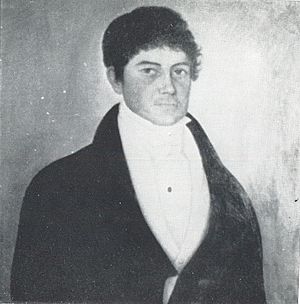Coffin (whaling family) facts for kids
The Coffin family was a very important family in the history of whaling in the United States. They operated their ships from Nantucket, Massachusetts, for a long time, from the 1600s to the 1800s. Some family members became famous because they discovered different islands in the Pacific Ocean.
Contents
The Coffin Family's Story
The Coffin family's journey in America began with Tristram Coffin. He was born in England in 1609. In 1642, he sailed to America, first living in Newbury, Massachusetts, before moving to Nantucket.
The Coffins, along with other families like the Gardners and the Starbucks, started whaling seriously around the 1690s. They hunted whales in the waters close to home. By 1715, the family owned three whaling ships (boats used for hunting whales) and one ship for trading goods. By 1763, six men from the Coffin family were captains of Nantucket ships. These ships sailed very far, reaching places like South America and Greenland.
James J. Coffin and His Discoveries
On May 31, 1823, a British whaling ship called Transit arrived in Batavia (which is now Jakarta) on the island of Java. Its captain had been lost to a whale near Christmas Island. James Coffin was on Java at that time and was chosen to be the new captain of the ship.
Later that same year, while working in the central Pacific Ocean, James Coffin is believed to have discovered Enderbury Island. This island is part of the Phoenix group. He named it after a whaling company from London called Samuel Enderby & Sons. However, when he talked about his other discoveries, like the Bonin Islands, to mapmakers, he didn't mention Enderbury Island.
On September 12, 1824, James Coffin also discovered the southern group of the Bonin Islands.
Joshua Coffin's Island Naming
Some old records suggest that Joshua Coffin, while he was the captain of the whaling ship Ganges, saw and named Gardner Island in 1825. This island is also in the Phoenix Group. He likely named it after Gideon Gardner, who was a U.S. Congressman and the owner of the Ganges ship.
However, other sources say that the island was seen by another whaler named Joshua Gardner. He was also reported to be the captain of the Ganges in 1825.
Reuben Coffin and the "Coffin Islands"
Some reports say that in 1823 or 1824, a "Reuben Coffin" was the captain of an American whaling ship also named Transit, which sailed from Nantucket. These reports claim he was the one who discovered the Bonin Islands. He anchored his ship near Haha Jima without anyone stopping him. He then claimed the islands for the United States and named them "Coffin Islands."
Owen Coffin's Difficult Journey
Owen Coffin (1802–1821) was a teenage sailor. He was on the Nantucket whaling ship Essex when it sailed into the Pacific Ocean in August 1819. They were on a sperm whaling trip. In November of the next year, a large whale hit their ship in the middle of the Pacific, causing the Essex to sink.
The surviving crew members spent months in a small whaleboat. They were starving and eventually decided that one person had to be sacrificed so the others could live. They drew lots (like picking straws), and Owen Coffin "lost." He was then shot and eaten by the other crew members.
Other Famous Captain Coffins
- Captain Hezekiah Coffin was the first American captain to sail around Cape Horn, a very dangerous tip of South America. He also commanded a Nantucket whaling ship called the Beaver. This ship carried whale oil to England. On its return, it carried 112 chests of tea from the British East India Company. The Beaver was one of three ships in Boston Harbour that had their tea cargoes thrown overboard during the Boston Tea Party on December 16, 1773.
- A Captain Coffin was the master of the whaling ship Baroness Longueville. He sailed her on a whaling trip between August 1816 and July 1819. The ship returned to Britain with 600 barrels of whale oil.
- Another "Captain Coffin" was the master and part-owner of the ship Thule from Nantucket. After 27 months at sea, his ship hit the "Booby Shoals" near the Chesterfield Islands on September 10, 1844, and was wrecked. The ship was carrying 1050 barrels of sperm oil. Two boats with 16 men managed to reach Moreton Bay, Queensland, in Australia on September 20. However, a third boat was lost. The sailors lost most of their belongings in the wreck, but people in Brisbane helped them with new supplies. Captain Coffin, Mr. W Thompson, and 13 crew members then traveled from Moreton Bay to Port Jackson (Sydney) on a steamer ship called Sovereign. Captain Coffin left Port Jackson on October 17 on a schooner called Vanguard, heading for New Zealand.
- After a Scotsman named Robert Hunter discovered the original "siamese twins" Chang and Eng in Siam in 1824, he worked with Captain Abel Coffin to sail them to America in 1829. Abel continued to travel with the twins, eventually buying out Hunter's share in the business.
- Records also tell of a "Captain Coffin" whose leg was badly hurt in a whaling accident. Since there was no doctor on board, Coffin ordered his mate to cut off his leg with a knife. He threatened to shoot the mate if he didn't obey. He held a pistol pointed at the mate during the entire operation.
See also
- Jethro Coffin House
- Mary Coffin Starbuck, daughter of Tristram Coffin


